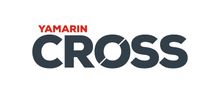Yamarin Cross concept boat: Exploring flax fiber and recycled materials in boat manufacturing
Can we find environmentally friendlier and technically superior alternatives to the traditional materials used in fiberglass boats? The new Yamarin Cross Concept Boat, unveiled at the Helsinki International Boat Show 2025, explores the use of natural fibers and recycled plastics in boat construction.
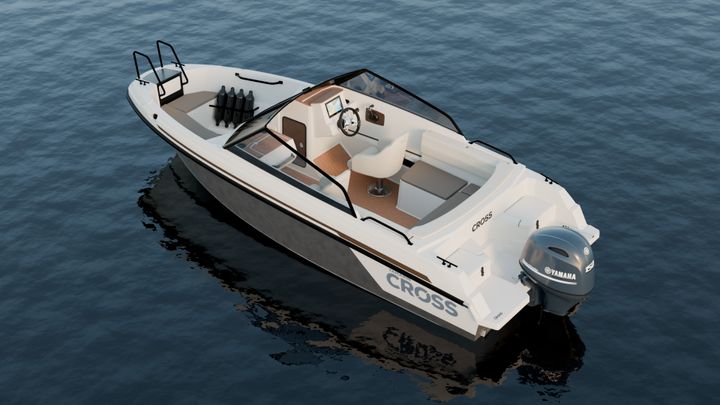
As part of a collaboration between Inha Works Ltd, manufacturer of Yamarin, Yamarin Cross, and Buster boats, and EKA Composite, the company responsible for lamination and assembling of the boats, tests more sustainable materials in this concept boat. The model is based on the popular Yamarin Cross 62 BR, and its structure incorporates:
- Recycled aluminum
- Flax fiber as a structural reinforcement
- Recycled PET plastic from used bottles
"Together with EKA Composite, we want to demonstrate that natural fibers and recycled materials can be used in boat manufacturing not only in an economically viable way but also to create stylish, high-quality boats," says Artturi Niittynen, Sales & Marketing Director at Inha Works.
The deck, manufactured with 100% Flax fibers instead of traditional fiberglass, for the Yamarin Cross 62 BR Concept Boat are manufactured in Finland by EKA Composite, while the aluminum hull is produced at Buster Boats' factory. Depending on the batch, 30–70% of the aluminum plates used in the boats come from recycled material.
- The concept boat will be on display at the Helsinki International Boat Show from February 7–16 at Booth 6 d 48.
Niittynen emphasizes that researching new materials and production methods is a key part of the company's development work. Yamaha Motor Corporation, the parent company of Inha Works Ltd, has committed to achieving carbon-neutral production by 2035, and these advancements support that goal.
"During this decade, we are working towards that target by minimizing energy consumption and transitioning to carbon-neutral and renewable energy sources," Niittynen explains.
The Inha Works Ltd and EKA Composite project will continue, with further details to be shared in spring and summer. The new materials will be tested during the upcoming boating season, and a commercial launch decision will be made based on testing and market feedback.
Flax Fiber Replaces Fiberglass in the Concept Boat
Traditional fiberglass boats are made using a composite structure, where fiberglass reinforcement is bonded together with polyester resin. In this concept boat, flax fiber fabric replaces the fiberglass reinforcement, significantly reducing environmental impact.
- 55% lower CO₂ emissions compared to fiberglass manufacturing (Source: Saertex)
- Lighter weight – Flax fiber composite weighs 1.5 g/cm³, compared to 2.54 g/cm³ for fiberglass
- Excellent mechanical strength – Long flax fibers (up to 90 cm) ensure high durability
"A portion of the boat's deck has been painted with a clear see-through gelcoat to highlight the beautiful, natural texture of the flax fiber," says Henna Forsström, Procurement Manager at EKA Composite.
Flax fiber not only enhances the boat’s aesthetics but also reduces weight. As a natural material, flax fiber has not yet been widely used in serial production of boats, but it has significant potential to partially or even completely replace fiberglass.
"Flax fiber is comfortable to handle in production and technically well-suited for boat components. The long fibers give it excellent mechanical properties, making it suitable for demanding applications," Forsström adds.
Recycled PET bottles as core material
In standard fiberglass boat construction, PVC foam boards are commonly used as core stiffeners for flat surfaces, forming rigid sandwich structures in floors and decks. The concept boat replaces PVC foam with PET foam, a material made entirely from recycled PET plastic bottles.
Additionally, the polyester resin used in the boat’s structure incorporates 22% recycled PET, further reducing the use of virgin fossil-based materials.
Lowering VOC Eemissions with advanced gelcoat
The gelcoat, which forms the outermost protective layer of the boat, is another area where improvements are being made. The Maxguard NP gelcoat, used in the concept boat, offers:
- Up to 50% reduction in volatile organic compound (VOC) emissions
- 10–15% material savings compared to traditional gelcoats
- Increased durability, high UV resistance, and excellent blister resistance
"The new gelcoat not only reduces emissions but also provides an exceptionally hard, stylish surface with superior resistance to marine conditions," Forsström explains.
Vacuum Infusion: Reducing waste and emissions
Beyond sustainable materials, the concept boat's production efficiency has been improved through vacuum infusion technology. This manufacturing method:
- Uses less material, creating a lighter and stiffer structure
- Eliminates styrene emissions during resin infusion
- Ensures better quality control and precision in boat building
“While deck lamination is just one part of manufacturing for Yamarin Cross, for us at EKA Composite, lamination is a core process that we continuously strive to improve in quality and environmental impact,” says Mikael Strand, CEO of EKA Composite.
The concept boat also includes Cork flooring – A renewable, non-slip, and comfortable material underfoot and Spradling Linetex fabric for upholstery – Produced by a carbon-neutral and ISO 14001-certified manufacturer using a closed water loop system
Industry collaboration for a sustainable future
Inha Works Ltd is also participating in the FurBio project, led by the University of Oulu, which explores the use of furfural, a byproduct of industrial side streams, as a raw material in resin production.
Furthermore, the EKA Composite concept boat project is part of the “Green Transition of Vacuum Infusion Process” project led by EKA Composite, which has received support from Finland’s ELY Centre and partial EU funding.
Towards carbon-neutral boat manufacturing
This project is part of a broader strategy within Yamaha Motor Corporation to achieve carbon-neutral production by 2035. Over the next decade, Inha Works Ltd will: Reduce energy consumption Transition to carbon-neutral and renewable energy sources
The initiative represents a step forward in sustainable boat building, and real-world testing during the 2025 boating season will determine the potential for commercial production.
Keywords
Contacts
Artturi NiittynenDirector, Sales and Marketing
Tel:+358 40 843 6988artturi.niittynen@cross.boatsHenna ForsströmEKA Composite Ab
Tel:0400 356 564henna@ekacomposite.comImages
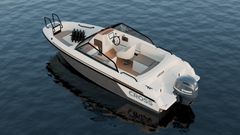
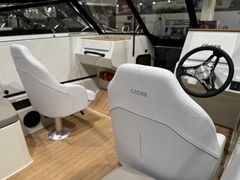
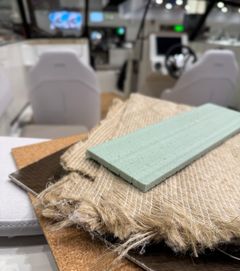
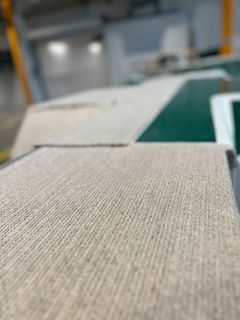
Links
Alternative languages
Subscribe to releases from Yamarin Cross
Subscribe to all the latest releases from Yamarin Cross by registering your e-mail address below. You can unsubscribe at any time.
Latest releases from Yamarin Cross
Venemessujen uutuus on luonnonkuituja ja kierrätysmateriaaleja hyödyntävä Yamarin Cross -konseptivene6.2.2025 15:30:00 EET | Tiedote
Voiko lujitemuoviveneen vakiintuneille rakennusmateriaaleille löytyä ympäristövaikutuksiltaan vähäisempiä, teknisesti jopa parempia vaihtoehtoja? Helsingin venemessuilla esiteltävässä uudessa Yamarin Cross -konseptiveneessä testataan muun muassa luonnonkuitujen ja kierrätetyn muovin käyttämistä veneen rakenteissa.
Den innovative Cross 55 BR viser vei for fremtidens Cross-båter13.8.2024 16:55:01 EEST | Tiedote
Den nye Cross 55 BR introduserer innovative løsninger som baner vei for fremtiden til Cross-båtserien, som er kjent for sine utmerkede kjøreegenskaper. Den nyeste aluminiumsbåten i Cross-serien er en 5,54 meter lang åpen båt i den mest populære størrelseskategorien for bowriderbåter.
The innovative Cross 55 BR sets the direction for the future Cross boats13.8.2024 16:55:01 EEST | Press release
The new Cross 55 BR introduces innovative solutions that pave the way for the future of the Cross boat range, known for its excellent driving characteristics. The latest aluminum-hulled Cross is a bowrider-type boat, measuring 5.54 meters, and it belongs to the most popular size category of open outboard boats.
Den innovativa Cross 55 BR visar vägen för Cross-båtarnas framtid13.8.2024 10:15:41 EEST | Pressmeddelande
Den nya Cross 55 BR introducerar innovativa lösningar som banar väg för framtiden för Cross-båtserien, känd för sina utmärkta köregenskaper. Den senaste aluminiumbåten i Cross-serien är öppen, 5,54 meter lång och tillhör den populäraste storleksklassen av bowrider båtar.
Innovatiivinen Cross 55 BR on näyttää suuntaa uudistuvalle venemallistolle13.8.2024 10:15:41 EEST | Tiedote
Uuden Cross 55 BR:n innovatiiviset ratkaisut viitoittavat suuntaa hyvistä ajo-ominaisuuksistaan tunnetun Cross-venemalliston tulevaisuudelle. Tuorein alumiinirunkoinen Cross on avoveneiden suosituimpaan kokoluokkaan sijoittuva, 5,54 metriä pitkä Cross 55 BR.
In our pressroom you can read all our latest releases, find our press contacts, images, documents and other relevant information about us.
Visit our pressroom